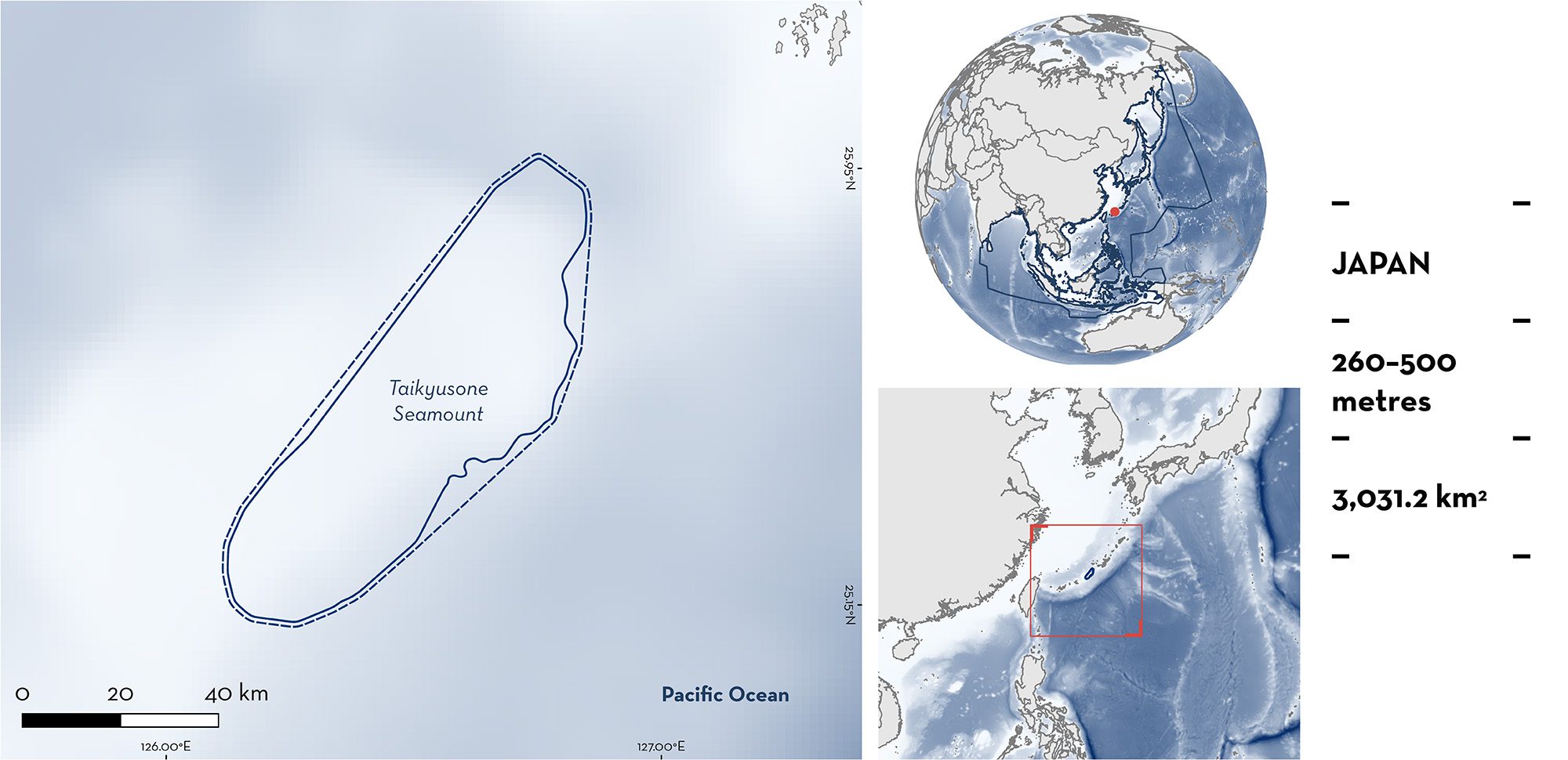ISRA FACTSHEETS
ISRA FACTSHEETS
ASIA REGION
Taikyusone Seamount
Summary
Taikyusone Seamount is located in the Miyako Strait between Okinawa and Miyako islands in southern Japan. This area is along the Okinawa Trough and next to the Ryukyu trench. The seamount has summits at 100 m. This area is characterised by the Kuroshio Current, a strong warm current 100 km wide that flows north-easterly along Japan’s east coast with a subsurface layer that carries a large amount of nutrients. This area partially overlaps with the Bluefin Spawning Area Ecologically or Biologically Significant Marine Area. Within this area there are: threatened species; range-restricted species; and reproductive areas (Shirai’s Spurdog Squalus shiraii).
Download factsheet
Taikyusone Seamount
DESCRIPTION OF HABITAT
Taikyusone Seamount is located in the Miyako Strait between Okinawa and Miyako islands in southern Japan. This area is along the Okinawa Trough and next to the Ryukyu trench (Sibuet et al. 1987). The seamount has summits at 100 m then drops to 2,000 m. This area is at the intersection of two Large Marine Ecosystems: East China Sea and Kuroshio Current.
This area is influenced by the Kuroshio Current, a strong warm current 100 km wide that flows in a north-easterly direction along Japan’s east coast (Guo 1991). The surface low nutrient content contrasts with a dark subsurface layer that carries a large amount of nutrients along the southern coast of Japan (Guo et al. 2013; Nagai et al. 2019).
This area partly overlaps with the Bluefin Spawning Area Ecologically or Biologically Significant Marine Area (EBSA; CBD 2024).
This Important Shark and Ray Area is benthopelagic and subsurface and is delineated from 260 m to 500 m based on the depth range of Qualifying Species in the area and the bathymetry of the area.
CRITERION A
VULNERABILITY
One Qualifying Species within the area is considered threatened with extinction according to the IUCN Red List of Threatened Species. Shirai’s Spurdog is assessed as Vulnerable (Rigby et al. 2023).
CRITERION B
RANGE-RESTRICTED
This area holds the regular presence of Shirai’s Spurdog as a resident range-restricted species. Shirai’s Spurdog is endemic to the tropical waters off southern Japan (Viana & de Carvalho 2020; Ziadi-Künzli et al. 2020; Ebert et al. 2021). During four vessel research trips (October 2011, August and October 2012, and November 2013), 726 Shirai’s Spurdogs were collected from this area using deepwater benthic longlines between 29 and 360 m deep (Sakurai 2014). Specimens were positively identified by Ziadi-Künzli et al. (2020). This sample collection represents the largest number of Shirai’s Spurdog ever collected. Many species of the Squalus mitsukurii-clade, in which this species belongs (Ziadi-Künzli et al. 2020), are localised endemics, and often form large aggregations or small schools segregated by sex (Ebert et al. 2021).
CRITERION C
SUB-CRITERION C1 – REPRODUCTIVE AREAS
Taikyusone Seamount is an important reproductive area for one shark species.
In October 2011, August–October 2012, and November 2013, 726 Shirai’s Spurdogs (female = 505, male = 221) were collected from this area during four vessel research trips using deepwater benthic longlines drifting over the seamount between 29 and 360 m deep (Sakurai 2014). Females ranged in size 35–85 cm total length (TL) (72.6 ± 6.9 cm TL, mean ± SD), and males 37–69 cm TL (62.5 ± 4.5 cm TL). A total of 397 females were analysed for reproductive characteristics (Sakurai 2014). Among the sexually mature females (n = 284), 81% (n = 231) were pregnant at different stages, with the majority in an advanced stage of development (n = 173; 68–83 cm TL) with the largest embryo measuring 27.3 cm TL. The mean (±SD) size-at-birth for Shirai’s Spurdog is 24.7 ±1.3 cm TL (n = 23) (Sakurai 2014) which is similar to the closely related Shortspine Spurdog Squalus mitsukurii (21–30 cm TL; Ebert et al. 2021). Therefore, this area functions as a gestation area. No neonates were sampled, most probably due to the sampling method used that selects larger individuals. This is the only area in which pregnant females have been documented across the species’ restricted geographic range, as this is the first study that has determined size-at-birth and litter size. Most males were sexually mature (n = 212; 96.3%) (Sakurai 2014). Therefore, this area might also function as a mating area. More information is required to confirm this.
Download factsheet
SUBMIT A REQUEST
ISRA SPATIAL LAYER REQUEST
To make a request to download the ISRA Layer in either a GIS compatible Shapefile (.shp) or Google Earth compatible Keyhole Markup Language Zipped file (.kmz) please complete the following form. We will review your request and send the download details to you. We will endeavor to send you the requested files as soon as we can. However, please note that this is not an automated process, and before requests are responded to, they undergo internal review and authorization. As such, requests normally take 5–10 working days to process.
Should you have questions about the data or process, please do not hesitate to contact us.


